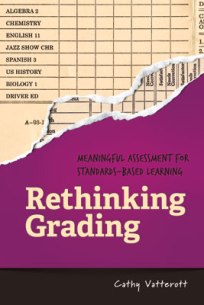 My Dean of Faculty recently gave me a copy of Cathy Vatterott’s Rethinking Grading: Meaningful Assessment for Standards-Based Learning as I will be heading a group of faculty member examining whether our assessment practices actually support the style of teaching we are doing at my school. Although I am only a few chapters into the book, I must say it is as if Ms. Vatterott reached into my head and pulled out exactly what I have been thinking for years.
My Dean of Faculty recently gave me a copy of Cathy Vatterott’s Rethinking Grading: Meaningful Assessment for Standards-Based Learning as I will be heading a group of faculty member examining whether our assessment practices actually support the style of teaching we are doing at my school. Although I am only a few chapters into the book, I must say it is as if Ms. Vatterott reached into my head and pulled out exactly what I have been thinking for years.
As an English teacher, I have always had a particularly difficult time using the traditional grading system as a way to assess my students. To me, putting a number grade on someone’s reading and writing ability is challenging and sometimes seems impossible. Rubrics have helped, but I struggle with the idea of putting a final grade on a piece of writing. Writing, I firmly, believe is a process. How do you put a final grade on a process? Even more difficult is evaluating creative and personal writing. How do you put a grade on a piece of poetry? On a personal narrative that a student poured her heart an soul into? How can I teach a love and passion for writing and reading through archaic evaluative systems?
More importantly, if we are out to foster a growth mindset in our students, traditional grading systems are not the way to do it. As much as we can pretend that allowing the student to re-write the D paper doesn’t affect their attitude toward learning, we are kidding ourselves. That D does nothing to tell the student how far he has come or what he has learned in the process – it is merely a reminder that they are not considered “good enough” no matter how much work and effort they placed. And if we really sat and thought about it, how often does that D just go away? Students are very quickly trapped into the grades they receive, or so it seems. Vatterott writes:
The patterns of school failure in the traditional system tend to reinforce the fixed mindset as the same students fail over and over again. As those students come to believe they’re just not smart, the mindset becomes a self-fulfilling prophecy. Struggling students begin to avoid learning. “Given all this, why persist?” they say. For the struggling learner, failure feels like fait accompli – a permanent caste system for C students and below.
– Cathy Vatterott, Rethinking Grading, 31
I am eager to learn more about Vatterott’s thoughts regarding how standard-based grading can help create a shift in a student’s motivation and lead to what most of us teachers are after: working with students who value and appreciate learning and are not just there to get their name on the honor roll.
More to come!

